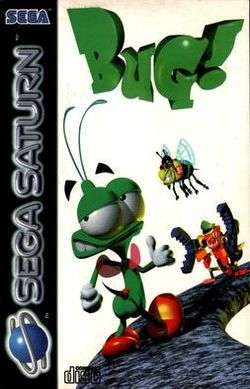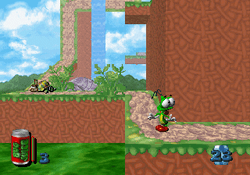Bug!
| Bug! | |
|---|---|
 European cover art | |
| Developer(s) | Realtime Associates |
| Publisher(s) | Sega |
| Producer(s) | David Bean |
| Designer(s) |
Cheryl Harada Steve Shimizu |
| Programmer(s) | Michael Dimambro |
| Composer(s) | Greg Turner |
| Platform(s) | Sega Saturn, Microsoft Windows |
| Release date(s) |
Saturn Microsoft Windows |
| Genre(s) | Platform |
| Mode(s) | Single-player |
Bug! is a platform video game developed by Realtime Associates and published by Sega for the Sega Saturn. It was first released in North America in 1995 just weeks after the Saturn's launch there, in Europe on 15 September 1995 and in Japan on 8 December 1995. It was also ported to Windows 3.1x and Windows 95 in 1996 by Beam Software. The game centres around Bug, a Hollywood actor who hopes to gain fame by defeating the villainous Queen Cadavra.
The game was developed with the titular character being considered a possible mascot for the Saturn. This was due to the absence of a Sonic the Hedgehog game at the time of its launch, however the game failed to catch consumer attention. It was one of the earliest examples of 3D platforming as well as the first platform game released on the Saturn. Bug! received positive reviews upon release; critics praised its graphics and colourful visual effects, however the game's music and voice acting were criticised. A sequel, Bug Too!, was released for the Saturn in 1996.
Gameplay

Bug! is a 3D platform game which revolves around the player safely progressing through various levels. The game is set on "Bug Island" and consists of six worlds made up of three levels each, with each last level culminating in a mandatory boss fight.[1] Enemies come in the form of insects and are defeated by jumping on them. Each level ends when the player jumps on a "Bug Stop", which will then make the player proceed to the next level.[2][3][4] Every level contains collectable items: 1-UPs supply the player with an extra life, collecting a heart will restore one hit point to the player whereas Bug Juice will fully replenish it, and a coin will allow the player to take part in a bonus round whereby they are given the chance to win more lives.[5][6] If the player runs out of Bug Juice, they lose a life. The game will end once the player runs out of continues.[7]
Collectable items in the form of blue crystals are found scattered throughout the game's levels. If the player collects 100 of them, they will earn an extra life along with a dragonfly icon, in which three icons are needed for the player to take part in a special bonus round involving a dragonfly ring chase.[8] In addition, the player can collect power ups which will enable them to defeat enemies instantly. These come in the form of "zap" and "spit" attacks; the former allows Bug to fire missiles made out of saliva, and the latter unleashes a bolt of electricity.[9][6] The levels featured in Bug! are linear – the player may only move in four directions despite the game appearing in full 3D.[10] In addition to walking on a grid axis, the player-character can also walk up walls and upside down.[6]
The game's plot centres around the titular character, Bug, who is a Hollywood actor hoping to make his "biggest break". Bug decides to sign up for the lead role in an upcoming action film, in which his girlfriend is kidnapped by the villainous Queen Cadavra and must set out to rescue her.[11]
Development and release
This is the character! This is the character that is going to do it for Saturn!
Steven Spielberg at the Consumer Electronics Show in Las Vegas, 1995.[10]
Bug! was conceptualised as one of three candidates for "would-be" mascots for Sega's upcoming Sega Saturn console in 1994, due to the lack of a Sonic the Hedgehog game upon the console's launch.[12] The other potential candidates were 2.5D platformers Clockwork Knight (which came out shortly before Bug!, at the Saturn's North American launch[13]) and Astal, which was released later in 1995.[10] The titular character Bug was thought to have imitated Sonic the Hedgehog's appearance and attitude in order to make it an effective mascot. At the Las Vegas Consumer Electronics Show in 1995, Steven Spielberg declared that Bug was the character "that is going to do it" for the Saturn.[10] Realtime Associates developed the game using Silicon Graphics workstations, which were then used to pre-render the game's characters and then convert them into sprites – in similar vein to the process used in Donkey Kong Country.[10]
Bug! was one of the earliest examples of a 3D platforming game. It was also the first platform game to be released on the Saturn in Europe.[14] By the end of 1995, 150,000 copies of Bug! had been sold in the United States, making it the second most popular Saturn game behind Daytona USA. According to Sega, discussions were underway for an animated TV series, though this never materialised.[15] A direct sequel, Bug Too!, was released for the Saturn in 1996.[16]
Reception
| Reception | ||||||||||||||||||||||||||
|---|---|---|---|---|---|---|---|---|---|---|---|---|---|---|---|---|---|---|---|---|---|---|---|---|---|---|
| ||||||||||||||||||||||||||
Bug! received positive reviews upon release. The Saturn version holds an average score of 84 percent at GameRankings, based on an aggregate of two reviews,[17] whereas the PC version has an average score of 55%, based on an aggregate of two reviews.[18]
The 3D graphics were praised by critics. Andy McNamara from Game Informer thought that the game's visuals were its strongest feature, stating that the "amazing" graphics were "perhaps the best part of Bug!". In the same review, Paul Anderson commended the game's pre-rendered bosses and SGI cutscenes.[19] Lee Nutter from the Sega Saturn Magazine felt disappointed that the game was not in true 3D, although he declared that it was a "really smooth and visually stunning" game.[14] Mike Weigand from GamePro praised the game's large and visually detailed levels, whilst asserting the graphics were "excellent".[20] A reviewer from Entertainment Weekly described Bug! as a showcase for the Saturn's "dazzling 3D-style graphics".[23]
Mark Reed of Maximum thought that the game was graphically a "mixed bag", praising the well-defined sprites and animations whilst criticising the backdrops, stating that they looked "often too blocky" and repetitive, although he admitted that it improved in later levels.[22] Neil West from the Next Generation Magazine thought the graphics were "solid", despite recognising that the game was mostly a direct transition from a 2D format into 3D.[21] Chris Broesder of AllGame thought that the graphics added to the overall experience of the game, stating that the characters were colourful and of "cartoon quality", although he noted that some textures were "a bit blocky" when zoomed in on.[2] Amalio Gomez of Hobby Consolas praised the sprite renderings and 3D environments as "beautiful", stating that the game took advantage of the Saturn's power and possibilities.[24]
The game's music and sound effects were praised, although the dialogue was met with criticism. McNamara disliked the voice acting of the Bug character, stating that it was too "Gex-wanta-be".[19] Weigand praised the game's jazz music, vocals, and underscore, although he too disapproved of Bug's annoying and "nasal one-liners".[6] Reed was disappointed with the audio aspect of the game, opining that Saturn's chipset was not used to its full potential as it produced lacklustre music. In addition, Reed stated that Bug's voice samples were "very unfortunate" and irritating.[22] Broesder, however, stated that the sounds add to the game's overall experience and was of high quality, although he felt bothered that the voices repeated themselves "over and over again".[2] Gomez praised the sound effects and music, saying that the music was "intense" and the sound effects increased the "realness" of the player's actions.[25]
References
Citations
- ↑ Realtime Associates 1995, p. 12-14.
- 1 2 3 4 Broesder, Chris (14 November 2014). "Bug! review and overview". AllGame. All Media Network. Archived from the original on 24 November 2014. Retrieved 2 November 2016.
- ↑ Realtime Associates 1995, p. 15.
- ↑ Gomez 1995, p. 76.
- ↑ Realtime Associates 1995, p. 10-11.
- 1 2 3 4 Weigand 1995, p. 45.
- ↑ Realtime Associates 1995, p. 8.
- ↑ Realtime Associates 1995, p. 8, 10.
- ↑ Realtime Associates 1995, p. 6, 7.
- 1 2 3 4 5 Buchanan, Levi (2 February 2009). "What Hath Sonic Wrought? Vol. 10". IGN. Ziff Davis. Retrieved 1 November 2016.
- ↑ Realtime Associates 1995, p. 4.
- ↑ "Bug! (review)". Electronic Gaming Monthly. 7 (73): 38. August 1995.
- ↑ "1995: The Calm Before the Storm?". Next Generation. Imagine Media (13): 47. January 1996.
- 1 2 3 Nutter 1995, p. 94.
- ↑ Nikei 1996, p. 23.
- ↑ "Bug Too! review". Game Revolution. CraveOnline. 6 June 2004. Retrieved 26 November 2016.
- 1 2 "Bug! for Saturn". GameRankings. CBS Interactive Inc. Retrieved 1 November 2016.
- 1 2 "Bug! for PC". GameRankings. CBS Interactive Inc. Retrieved 1 November 2016.
- 1 2 3 McNamara, Andy (September 1995). "Not To Be Denied!". Game Informer. Archived from the original on 20 November 1997. Retrieved 1 November 2016.
- 1 2 Weigand 1995, p. 44.
- 1 2 West 1995, p. 89.
- 1 2 3 Reed 1995, p. 147.
- 1 2 "Bug!: Digital Capsule Review". Entertainment Weekly. Time Inc. 25 August 1995. Archived from the original on 6 October 2008. Retrieved 1 November 2016.
- 1 2 Gomez 1995, p. 77.
- ↑ Gomez 1995, p. 76, 77.
Bibliography
- Nutter, Lee (November 1995). "Bug! review". Sega Saturn Magazine. Future plc (1): 94. Retrieved 1 November 2016.
- Weigand, Mike (September 1995). "Bug! review". GamePro. IDG Entertainment (74): 44, 45. Retrieved 1 November 2016.
- Nikei, Wes (January 1996). "32-Bit Game Busters: Quick Hits". GamePro. IDG Entertainment (78): 23. Retrieved 2 November 2016.
- West, Neil (September 1995). "Bug! review". Next Generation Magazine. Future plc (9): 88, 89. Retrieved 1 November 2016.
- Reed, Mark (September 1995). "Bug! for the Saturn". Maximum. EMAP plc (1): 147.
- Gomez, Amalio (October 1995). "Bug: Comienza Una Neuva Era En Las Platformas". Hobby Consolas (in Spanish). Axel Springer (1): 74–77. Retrieved 2 November 2016.
- Realtime Associates (1995). Bug! instruction manual. Sega. pp. 1–15.
External links
- Bug! at Satakore